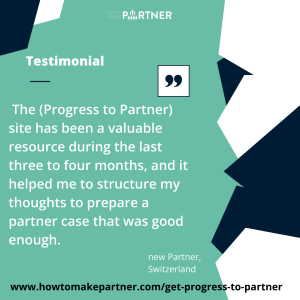Your Partnership Track Plan is what will keep you literally ‘on track’ to achieve your goal of being voted into the partnership in your firm. Given the multiple demands on your time when you are on partnership track, particularly if you are on Partnership Track in a law firm, it can be so easy to lose focus on what is important to you right now.
This is where your Partnership Track Plan comes in. In this post, we explore what should be in your Partnership Track Plan. What goes in your Partnership Track Plan will be personal to your own particular circumstances. However, it is likely to contain all or some of these parts.
Marketing plan:
This is used to show your partners that you are able to build and maintain a partner-sized profitable client portfolio. It is likely to contain:
- Your personal marketing plan to attract new clients
- Key account plans to grow your current client portfolio and generate work-winning opportunities for other people in the firm
- A networking strategy to build strong referral networks, grow your profile and reach
- Your pipeline and what you need to do to progress each opportunity so that it becomes a client
Internal PR campaign plan:
When it comes to the partnership vote you want every partner to say yes to you becoming a partner in the firm. This means that they need to know who you are, respect you, and feel that you are already thinking and acting like a partner. Click here to download my FREE Guide to Creating your Internal PR Campaign.
Your PR Campaign Plan should include:
- A stakeholder map of the key movers and shakers in your partnership and how you intend to positively influence and engage with them
- An activity plan to grow your profile across the firm
- Take a step forward to be in control of your own career progression in your firm. Sign up to my weekly newsletter here and you’ll find out what you need to be working on in your career development (and how to make the time for your career development) to progress your career in your firm.
Personal development plan:
 The skillset needed by partners in a firm is very different to non-partners. For example, most people find that running a business is a skill set that needs to be learned rather than something that comes naturally to them. This part of your plan is likely to contain:
The skillset needed by partners in a firm is very different to non-partners. For example, most people find that running a business is a skill set that needs to be learned rather than something that comes naturally to them. This part of your plan is likely to contain:
- How you will gain the skill set and experience to be seen to be acting as if you are already a partner
- Identification of your weaknesses and strengths, and how you will capitalise on your strengths and mitigate your weaknesses
- How you will actually get the time to recharge and keep your energy high
All the resources and guidance that you will need to put together a cast-iron business case for partnership is waiting for you in Progress to Partner (online) Academy. Buy your Premium membership for just £290* for 12 months here .
Team development plan:
You are unlikely to make it to partner without the support of a team behind you. After all, you don’t want your own partnership ambitions to be jeopardised by the lack of successor to take over your current workload! This part of your plan is likely to contain:
- Individual development plans for your team
- A development plan for your whole team to engage them in your vision for the future
Short-term 90-day action plan
With so many plans to keep an eye on, it can be easy to forget about the action steps in one of the plans. Your short-term 90-day action plan will be where you condense all of your plans, into one document detailing what you need to do and achieve in the next 30, 60 and 90 days.
In summary
 Getting through partnership track to partner is a hard slog.
Getting through partnership track to partner is a hard slog.
With the many demands on your time with just doing the day job it is easy to deprioritise your own career progression.
Use your Partnership Track Plan to help you keep focused on your own development and enable you to see how far you have truly come.
There are entire sections in my Progress to Partner Academy that will help you to work on your business case skills
14 Self-study courses, including:
a) Creating Your Cast-Iron Business Case For Partnership‘.
b) How to become the Go-To Expert (build your client portfolio)
c) How to find the time for Business Development
d_ How to Delegate Like a Pro
e) How to Excel as a Line Manager
PLUS
- A section on the Partnership Admissions process with guides and recordings to help you find your way through the process with your sanity intact.
- Recordings and checklists on how to ace your partner panel interview.
- Sample slide deck to use to structure your presentation for your Partner Panel Interview.
- Proven advice on how to still do the day job and find the time to get through the Partner Track process.
Imagine how your business case would look if you worked through these courses and the other resources throughout your 12-month membership!
All the resources and guidance that you will need to put together a cast-iron business case for partnership is waiting for you in Progress to Partner (online) Academy. Buy your Premium membership for just £290* for 12 months here .








